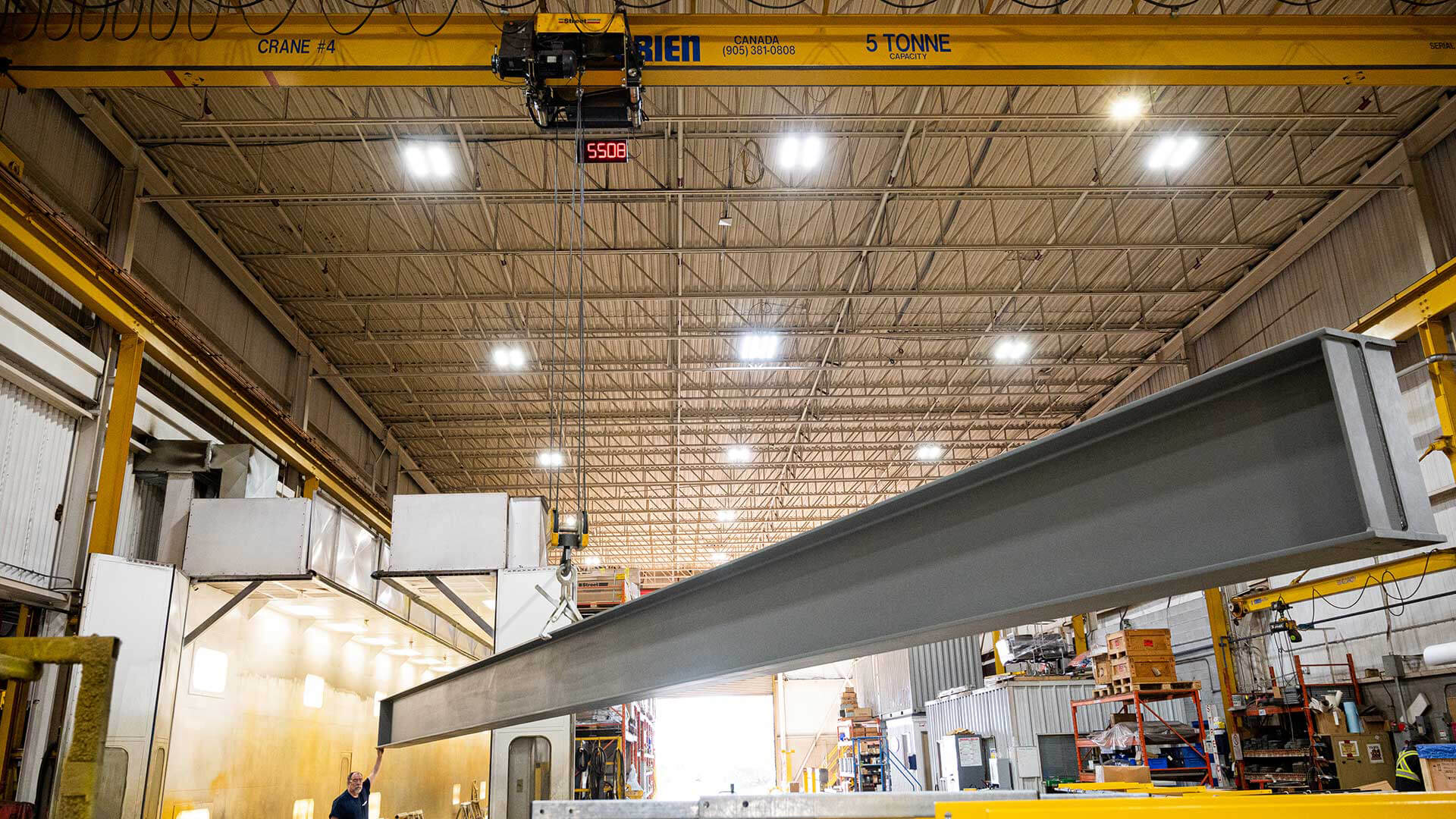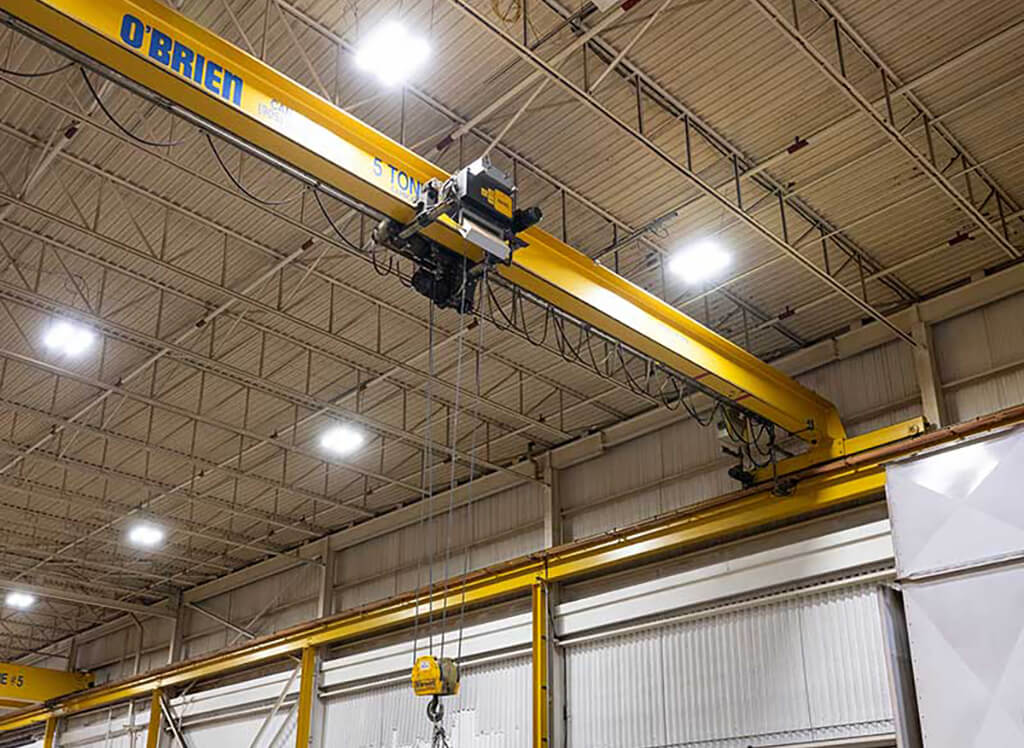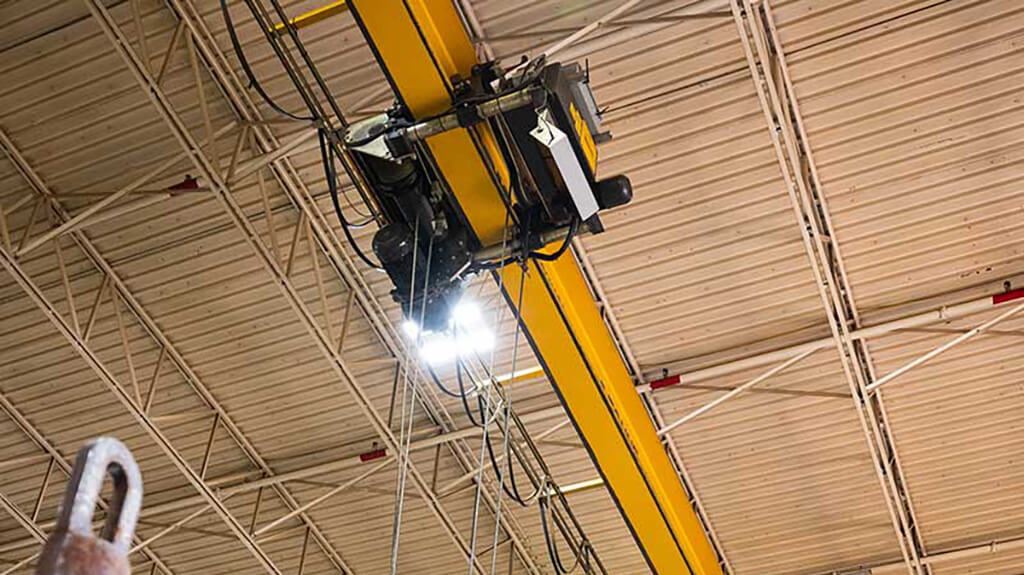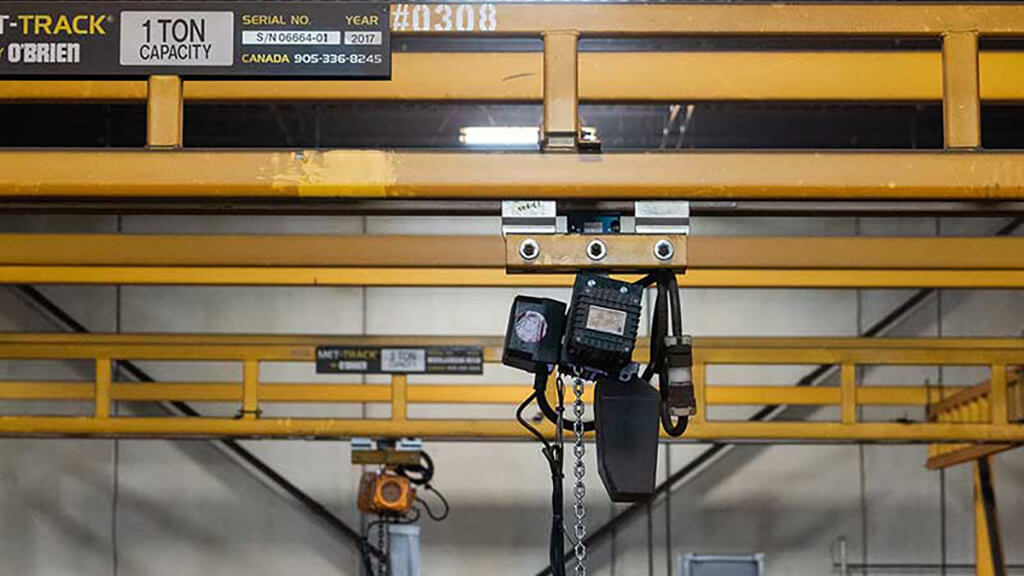
While many of our clients come to the team at O’Brien Lifting Solutions with an idea of what they want to install in their shop, or are looking for industrial crane maintenance, or wire rope hoists, some come to consult on which system is best to provide maximum efficiency and productivity for their industrial processes.
Over the next few articles, we’ll be discussing the advantages and disadvantages of different types of systems, and how you could use them to ensure your business runs smoothly. Today we’re discussing overhead cranes, and different types of hoists – chain hoists and wire rope hoist systems.
Overhead Crane (Bridge Crane)

An overhead crane (bridge crane or overhead bridge crane) is used for heavy-duty lift handling. It’s commonly seen in automotive parts, warehouse/distribution, commercial printing, steel works and other manufacturing settings. Anywhere you need to lift heavy loads and move them through an industrial process.
Overhead cranes can be used to load / unload trucks, delivering raw materials in a manufacturing facility, lifting dies out of stamping machines, moving parts down an assembly line (e.g., engines in an automotive manufacturing facility), moving containers around a warehouse or shipyard.
Overhead Cranes – Key Concepts

There are many different types of overhead bridge cranes, what is best for your business depends on a number of factors such as crane capacity, bridge span, and hook height. Before we go further, let’s explain these terms:
- Crane capacity – the maximum lifted load is a critical calculation for your business. This is the beginning point for all crane design and allows the manufacturer to accurately recommend a crane system to the customer.
- Crane Duty Classification – Crane duty classification is categorized in letters A through F and is determined by the amount of use a crane will see during its daily life cycle. A is the most infrequent use, and F is the most extreme continuous use. This is a very important factor and needs to be assigned as accurately as possible, otherwise you could require constant maintenance on your crane which becomes costly!
- Bridge span – the span, or bridge span, is the width of the overhead crane, or the horizontal distance between the rails on which the crane travels.
- Girders – most overhead crane systems can be single or double-girder. Single-girder systems have one bridge girder while, of course, double-girder systems have two. In general, double-girder systems can handle heavier loads.
- Hook height – hook height, or lift height, is the distance from the floor to the hook in its highest position. Understanding lift height is critical to ensure there is enough room to lift your desired load.
Different Types of Overhead Crane Systems
There are various types of overhead cranes to suit a variety of specifications and work environments.
- Top Running Overhead Cranes – top running cranes are an effective solution for lifting and moving heavy loads. In these systems, the bridge moves on top of a runway system supported by engineered columns or building columns. Top-running cranes allow for long bridge spans, and provide a lot of headroom for lifts. They can handle small to large capacity loads and are typically the most common type of overhead crane used in manufacturing.
- Under Running Overhead Cranes – under running cranes look similar to top-running cranes, but the bridge runs directly along the bottom flange of the runway beams, instead of running on crane rail like a top running crane does. Under running overhead cranes are an ideal solution when floor space is limited, and you can sacrifice some headroom.
- Monorail cranes – like the name implies, monorails employ a single straight, curved or winding beam to lift and move loads throughout a facility. Monorail cranes are generally cost-competitive, and range from 500 lbs to 10 ton typically. However, special designs can accommodate much higher capacities, all the way to 25 Ton. The key benefit to a monorail is its inline travel, greatly improving your operator’s ability to precision place a load repeatedly in the same position. These systems can be ceiling or floor mounted.
Choosing the Right Hoist Type: Chain Hoist & Wire Rope Hoist

Another major decision is the hoist type – chain hoist or wire rope hoist. The hoist is the main lifting device for your crane – each type of hoist delivers unique benefits, so it’s important to choose the right hoist for your jobs. It’s important to realize one hoist is not better than the other, it’s all about applying the right tool for the job!
- Chain hoists – Chain hoists are commonly used in light capacity applications, typically ranging from ⅛ Ton to 5 Ton. They can be purchased as electric powered or manual, in both the hoisting movement and the trolley movement.
Some of the benefits of a manual or electric chain hoist is that they are more cost effective, easy to move to a new crane or location, can have their height of lift modified for new applications, and offer in line lifting with no hook drift because they operate through a single sheave typically, and are widely available in a range of voltages.
- Wire rope hoists – Wire rope hoists have a much larger capacity range then chain hoists, ranging from 1 Ton to 200 Tons. While they are a more expensive hoist option, they often provide greater control over a load in a higher capacity range.
Some of the advantages to a wire rope hoist is that they can be purchased with true ramp and hold variable frequency drives, offering the operator greater control over their lifted load, the speeds can be configured to be faster or slower, wire rope hoists have more reeving which lowers the load and therefore the wear on drivetrain components, and are available in duty classes ranging from A to F. Some of the disadvantages of a wire rope hoist is that it needs to be wound around a single drum and therefore when the rope unspools there will be drift on the hook from top to bottom position. Wire rope hoists often are made of more expensive components and generally can be more costly to fix than a chain hoist.
The most important take-away should be that both of these hoists work well when applied to the correct application. It’s even more important to consult a crane professional on this and to make sure your crane operators have completed crane training and have given their hoist operator manual a read to make sure they know what is acceptable when using the hoist.
Contact O’Brien Lifting Solutions for Crane Design & Wire Rope Hoists for Your Workplace
O’Brien Lifting Solutions provides creative crane solutions, with production and installation services to get you working quickly. We consult with you to provide standard and customized solutions to help maximize your productivity and minimize your downtime. All our cranes meet or exceed Crane Manufacturers Association of America (CMAA) specifications. You can trust the quality of our products, industry knowledge and expertise, and commitment to the success of your project. Contact us today to request a quote on your project.Follow O’Brien Lifting Products on Facebook or LinkedIn.
